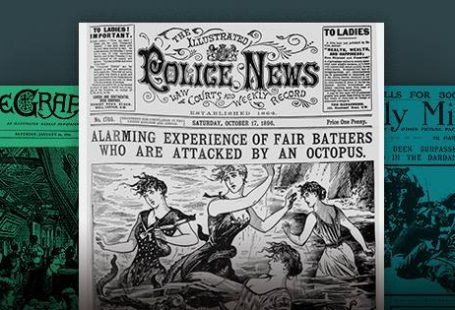It’s been another busy week for us here at The Archive as we have added 148,050 brand new pages over the past seven days. We are also delighted to welcome five brand new titles, hailing from Blackpool to Bridgend, from Dorset to Kenilworth, and a very special paper which was aimed at cotton factory workers in Lancashire.
So read on to find out more about the Cotton Factory Times, our four other new regional titles, as well as to learn more about the extensive updates we have made to nine of our existing titles.
Register now and explore the Archive
Heading up our new titles this week is the Cotton Factory Times. First published on the 16 January 1885, it was the brainchild of newspaper owner John Andrew, who ran the Ashton Evening Reporter. It was his aim to sell more newspapers to workers at the local cotton factories in Lancashire and Cheshire, and to do that he believed he needed to create a newspaper aimed solely at this demographic.
Cotton Factory Times | 27 March 1885
And so it was that he established the Cotton Factory Times, which was printed in Manchester and appeared every Friday, priced at one penny. Drawing on famous cotton trade unionists, including Thomas Ashton, Thomas Birtwistle and James Mawdsley, the newspaper’s first edition offered itself as a voice of those workers involved in the cotton trade, ‘a battle-ground upon which the social questions of the operatives, and the questions affecting their labour, may be debated and settled.’
It goes on to describe how:
The ‘Cotton Factory Times’ does not appear in any way as a firebrand, but as a peaceful and sincere friend of the operatives of Lancashire. Its columns shall be opened for their defence at all times, and who dare deny them as much right to an organ as any class of society?
So what could you find within the pages of this organ of the cotton factory workers? Well, there were sections including ‘Notes from the Factories,’ ‘Thoughts on Home Life,’ and ‘Voices from the Spindle and the Loom.’ All these sections combine to paint a vivid picture of what daily life was like at the cotton factories, from reports of accidents to reports of dismissals (one poor woman was dismissed for being fifteen minutes late!).
Cotton Factory Times | 3 January 1919
You could also find entertainment pages within the Cotton Factory Times, often employing the local Lancashire dialect. There were pages devoted to topical fiction, with stories like Very Hard Times or The Trials and Sorrows of the Linwood Family: A Tale of Lancashire Distress to be found. With news from the cotton trade, some columns devoted to ‘Foreign News’ and gardening notes, the Cotton Factory Times would have been a must-read for workers involved in the trade.
And it saw great success; by 1900 it was reportedly selling 53,000 copies an issue. It inspired the creation of other similar titles like the Yorkshire Factory Times and the Workman’s Times, Labour newspapers for those not involved in the textile trade.
Cotton Factory Times | 5 March 1920
However, circulation dipped in 1910 to 20,000 per issue, and halved again by 1918. In an effort to boost sales sections like ‘Mirth in the Mill,’ cartoons, and a ‘best joke’ competition were introduced, but that could not stop the newspaper’s terminal decline. It finally stopped printing in 1937, when sales had fallen to 2,500 per issue.
We move now to look at our other new titles. This week sees the introduction of the Kenilworth Advertiser. Published in the Warwickshire market town of Kenilworth, just south west of Coventry and home to the historic Kenilworth Castle, it appeared every Saturday priced at one penny. With a neutral political viewpoint, it had a circulation of 500 in 1882, the town of Kenilworth being home to 3,335 people at the time.
Kenilworth Advertiser | 15 December 1900
Our next new title is the Blackpool Gazette and Herald. Founded in 1873, this title appeared every Friday and was also priced at one penny. It covered the towns and communities on the Fylde Coast.
Blackpool Gazette and Herald | 18 February 1881
Moving further south, we have also added the Dorset County Express and Agricultural Gazette to our collection. Established in 1855 and published in Dorchester, it covered the local news from Dorset, from the towns of Weymouth and Poole, and the Portland peninsular. Dubbing itself the ‘the best paper for Farmers and Families,’ it was priced at 3d. and had a Liberal stance. An advert-heavy newspaper, it also included news from beyond Dorset as well as a useful ‘Calendar of Garden Work.’
Dorset County Express and Agricultural Gazette | 18 October 1881
Our final new title this week hails from Wales – the Bridgend Chronicle, Cowbridge, Llantrisant and Maesteg Advertiser. Published in Bridgend and priced at one penny, it was first published on 2 January 1880 by John Hopkin of 2 Union Street, Bridgend. Covering the local news from south Wales, this newspaper had a circulation of 6,800.
Bridgend Chronicle, Cowbridge, Llantrisant and Maesteg Advertiser | 23 November 1888
We’ve also added new pages this week to our existing titles. Of particular note are the long run of pages we have added to the Oxford Chronicle and Reading Gazette and the Fulham Chronicle, which span the late nineteenth and early twentieth centuries and together number some 30,000 pages. You’ll also find updates from the 1940s and 1950s to specialist cinema newspaper the Kinematograph Weekly, and we’ve also added more pages to our collection of Examiner titles from the North West of England. Finally, you’ll find updates to our international title the Civil and Military Gazette (Lahore).
A Day in the Life
In 1906 a new feature was added to the Cotton Factory Times – ‘For Wives & Maidens: Each for All and All for Each.’ Penned by ‘Vesta,’ this column was devoted to women’s interests and their welfare, as Vesta herself describes:
Vesta will be delighted to answer any letter sent to her on any subject connected with women’s welfare. Correspondents should use a pseudonym, and their letters will be answered in rotation.
In September 1906 Vesta announced a ‘Prize Competition,’ in which she would award prizes (of up to 5 shillings) ‘for the best descriptions of ‘A Working Day in My Life’ sent in by readers.’ The responses she received give a fascinating insight into the working lives of women during the early twentieth century.
Cotton Factory Times | 21 September 1906
The winner of the competition was announced on the 5 October 1906. Vesta remarks ‘What a difficult task the judging of the competition papers has been…All the papers are interesting, and most of them excellent.’
The winner was Miss M.A. of Rochdale, ‘who sends an interesting account of her day’s work as a baker…She has been working ever since the age of eleven…Although her hours are long she finds time to do a great deal of the family dressmaking in the evenings.’
At work in a cotton factory | Illustrated London News | 10 July 1909
In second place was Miss M.D. of Earby, who send an ‘interesting and lucid description of life in a weaving shed.’ Vesta seems to be most impressed by how late Miss M.D. gets up in the morning to go to work:
Miss M.D. is fortunate in living near to her work, so that she does not rise until 5.30, in order to be at her loom five minutes before the engine starts at six o’clock.
In third place was an elementary school teacher from Bolton. Again, Vesta comments on the teacher’s working hours (which were 8.30am to 4.30pm with two hours for ‘dinner’): ‘This may seem a short working day in comparison with that of many other occupations, but many of the evening hours have to be spent in hard study, leaving little time for recreation.’ Vesta is also charmed by ‘some of the funny sayings of her little charges, who are evidently warmly attached to her.’
‘Little Londoners Learning to Make Their Letters’ | The Sphere | 25 October 1902
Vesta also includes the fourth and fifth placed entries. In fourth was Miss J.R. of Oldham who ‘touches [Vesta’s] heart with her simple, natural account of a duty bravely done, in maintaining a home for an aged mother,’ as well as working in a cardroom for the ‘usual factory’ hours.
And in fifth was Miss M.H. of Fishponds, Bristol, outside of the usual Cotton Factory Times demographic. And this young woman’s working experience was outside of the usual for many of her contemporaries in the North West of England. Miss M.H. was working for chocolate makers J.S. Fry and Sons, a company which was ‘well-known [for the] interest it displays in its employees.’ Miss M.H. could expect to join in with prayers and hymns after breakfast, and was allowed to do her own ‘fancy-work’ during break hours.
Illustrated London News | 25 October 1902
And Vesta’s column, as well as showcasing the lives of ordinary women across the country, also includes some useful hints and tips for the home. On 26 October 1906 she gives advice on how to fix a greasy sink pipe (add paraffin, and then boiling soda and water), and how to ‘prevent cold feet’ (place a bolster at the end of the bed).
Finally, with Christmas coming up, Vesta gives some recipes for ‘Christmas fare’ that you may (or may not) like to try at home. One such recipe is brawn (for which you will need a pig’s eye and two tongues), whilst she also gives instructions on how to make ‘tomato sausages’ and ‘apple snow – a delicious sweet dish.’
The Cotton Factory Times is a fascinating window into the lives of cotton factory workers and beyond – you can start browsing it here, enjoy!
At work in a cotton factory | Illustrated London News | 10 July 1909
New Titles
Tilte |
Years Added |
| Cotton Factory Times | 1885-1888, 1891-1895, 1897-1899, 1902-1911, 1913-1920 |
| Blackpool Gazette & Herald | 1881-1886, 1888, 1890-1893 |
| Dorset County Express and Agricultural Gazette | 1881-1886 |
| Kenilworth Advertiser | 1900 |
| Bridgend Chronicle, Cowbridge, Llantrisant, and Maesteg Advertiser | 1888 |
Updated Titles
This week we have updated nine of our existing titles.
You can learn more about each of the titles we add to every week by clicking on their names. On each paper’s title page, you can read a FREE sample issue, learn more about our current holdings, and our plans for digitisation.
Tilte |
Years Added |
| Civil & Military Gazette (Lahore) | 1889-1890 |
| Leicester Evening Mail | 1946-1954, 1956-1959, 1963 |
| Kinematograph Weekly | 1945, 1950, 1952 |
| Widnes Examiner | 1883-1884, 1891, 1899, 1903, 1905, 1907, 1912-1914, 1916 |
| Runcorn Examiner | 1883-1884 |
| Warrington Examiner | 1904 |
| St. Helens Examiner | 1883, 1900 |
| Oxford Chronicle and Reading Gazette | 1871, 1874-1892, 1894-1895, 1900-1902, 1904-1906, 1908-1909, 1912, 1914, 1916, 1927-1929 |
| Fulham Chronicle | 1888-1904, 1907-1912, 1923-1933 |
You can keep up to date with all the latest additions by visiting the recently added page. You can even look ahead to see what we’re going to add tomorrow.


















